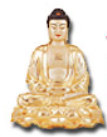
TEACHINGS IN CHINESE
BUDDHISM
BUDDHANET PRODUCTION
Preface
Venerable Dr. Yin Shun is one of the greatest contemporary Buddhist masters. He has spent more than sixty years in the Buddhist Order. Although he has throughout his life suffered almost constantly illness, his strong determination and perseverance has allowed him to complete a huge collection of works on Buddhism. Unfortunately, most of his works remain in Chinese. Only a very small proportion of them have been translated into English and Japanese. There are experts in Theravada; in the Mahayana; in Vajrayana; in Buddhist history; on Zen and on various other schools in Buddhism. But these scholars and masters each worked, for the most part, in a limited sphere, and very few of them can give us an integrated understanding of Buddhism as a whole. The Venerable’s collected works serve this purpose very well. They help clarify confusion regarding Buddhist practices and show us the right path in order to follow the teaching of Buddha.
Buddhism has a history of more than two thousand five hundred years. After the Buddha’s Parinirvana, His Dharma continued to develop and grow in India. Later, it spread throughout the countries of Asia, adapting its forms and rituals to individual cultures. During its development and propagation, the teachings of Buddhism were enriched and necessarily employed skilful means (s. upaya) in order to assist the transmission of the Buddha Dharma to different individuals. However, when these skilful means and the absolute truth lying behind Buddhism cannot be distinguished or understood clearly, confusion may arise and may even prevent us from pursuing true spiritual development.
As Venerable Yin Shun says in his preface to “Buddhism in India”,
“I deeply believe that during the long period of the development of Buddhism, some teachings have been changed and even deformed. Therefore, the core teachings of Buddhism have to be revealed and the cause of the change in the teachings has to be understood. Only with this will we be able to distinguish, clarify and distill the teachings.”
With these purposes in mind, as stated in “The Method and Attitude in Learning Buddhism”, Venerable Yin Shun has put most of his efforts into “searching what are the ultimate and core teachings in Buddhism? How does Buddhism develop over time? How has the teaching changed in India?” Furthermore, he uncovers the links between various teachings and presents the vast system of Buddhist thought as an integrated whole. Although not all the teachings we find in Buddhism today equally parallel the core teachings, Venerable Yin Shun is impartial with respect to the development and mutation of Buddhism through various schools and traditions. Instead of ridiculing the variety of practices and beliefs, he expounded the truth. When Venerable Yin Shun comments on a particular practice in Buddhism he does not draw us into hasty value judgements. He is always very patient. Customarily his commentaries start with an explanation of the origin of a certain practice, and then explicate how that given practice changes in order to create the forms we see today. In “The Method and Attitude in Learning Buddhism” Venerable writes: “It is not just a simple question of right or wrong. We have to perceive these changes as skilful means and as developmental adaptations.”
Venerable Yin Shun does not bind himself to any particular school or tradition. The way he approaches and learns Buddhism, as explained in “Learning Buddha Dharma Through Buddha Dharma”, is based on the Three Universal Characteristic of Buddha Dharma i.e.
‘All existence and phenomena are subject to change (s. anitya),
All existence and phenomena do not have any substantial reality (s. anatman),
The eternally serene state of Nirvana”
The state of Nirvana is the ultimate aim of all Buddhist practices. Therefore the teaching is to be studied, more to be practiced, and above all to be realized by oneself. Mere learning is of no avail without actual practice. Only by living in Buddha Dharma can its very essence be known.
The approach by which we understand Buddha Dharma should be grounded in an awareness of constant flux as the underlying nature of phenomenal existence (viz. anitya). Discourse on the Dharma also changes and grows as Buddhism historically develops. Therefore, we should “understand the changes in Buddhism in order to reveal what is the absolute teaching of the Buddha Dharma, and what are the relative truths which have been adapted from time to time.”
In practising Buddhism, we should have the attitude of egolessness. There are two aspects to egolessness (s. anatman), i.e. the non-existence of the individual soul (s. pudgala-nairatmya) and the non-self nature of Dharma (s. dharma-nairatmya). Because of the egolessness of the individual, “we should learn and practise Buddhism without becoming attached to our own view and should eschew all prejudice against others.” Because of the egolessness of Dharma “everything in this phenomenal world exists in the form of interdependence and interrelationship, conditioned by every other thing.” Therefore, when we study Buddhism we must also understand the interrelationship between the teachings and the Law of Dependent Origination. By following the Three Universal Characteristics of Buddha Dharma, Venerable Yin Shun illuminates for us the right way to learn Buddhism.
The Venerable’s collected works range widely and include, but are not limited to, Buddhist text books for primary schools; Dharma talks for general audiences; commentaries on sutras and sastras; a history of Buddhism in India; guides to Buddhist practices; and teachings from various schools and traditions. The selected translations which comprise Parts I and II are in total just a very small portion of the works of the Venerable. A substantial proportion of his important writings lie beyond our abilities to translate at this stage. We sincerely hope that more people will become involved in their translation in the future. On the other hand, we sincerely hope that even this limited selection will enrich the understanding of Buddhism in the West so that more people can benefit from contact with the Dharma.
This volume, “Selected Translations of Miao Yun Part II”, is our second humble attempt to translate works by Venerable Yin Shun. All the articles in this selection were selected from the eleventh volume of the Miao Yun Collection, namely “Buddha Dharma is the Light of Deliverance.” The articles we have selected can be broadly divided into two categories. The first category includes “Buddha Dharma is the Light of Deliverance”, “Buddha Come to Save and Protect Us”, “Two Distinctive Characteristics of Buddhism”, “Let Go of Your Sorrow”, “Form Relieving the Suffering of the Mind to Relieving suffering of the Body”, “The Critical Issue of Life and Death”, “What is the Significance of Life” and “Dharma About Lay People For Lay People”. All these articles deal with the fundamental understanding, perspective and practice of Buddhism. They try to answer questions such as: Why should we learn Buddhism? How can Buddhism help us? How do we face life from a Buddhist perspective? From an understanding of the unique characteristics of Buddhism we will be able to grasp the true significance of life, and furthermore realize this significance i.e. achieve Buddhahood in this very life. These are all important teachings of the Buddha that every Buddhist should understand from the very outset of his or her practises. The remaining articles in this selection deal with more advanced teachings in Buddhism such as voidness (s. sunyata) and the Middle Way. They assume some prior knowledge in this field and are therefore more suitable for those who have a deeper grounding in the Dharma.
We would like to take this opportunity to thank the Triple Gem for guiding our lives. We gratefully acknowledge and express deep appreciation to Venerable Tsang Hui for his guidance and encouragement. We would also like to thank Mr. Mick Kiddle. Mr. Gregg Heathcote and Mr. Michael Morrison for correcting our English and smoothing the writing. They have made this publication possible. These translations involved members from the University of New South Wales Buddhist Society, the University of Sydney Buddhist Society, the University of Newcastle Buddhist Society and Hwa Tsang Monastery Inc. Despite their busy academic and working lives, many people have contributed their time and energy so that these translations could be completed.
We are responsible for any possible mistakes and distortions in the translations and any remedial suggestions from you would be very precious, and very welcome. We hope that we have succeeded in presenting these works of Venerable Yin Shun to you as faithfully and clearly as we can.
Finally, let us share a message from Venerable Yin Shun:
“Faith in the Triple Gem should be developed from right understanding. The faith derived from right understanding will lead us to skilful action and further our progress on the path of Buddhahood. Let us bring benefits both to ourselves and to others. Let us contribute ourselves to the promotion of Buddha Dharma.”
Beng Tiong Tan
Newcastle, Australia
10 July 1996

